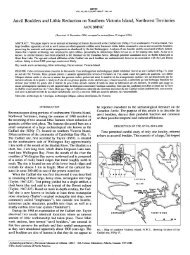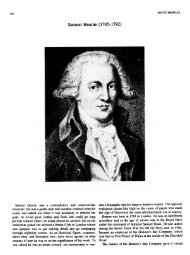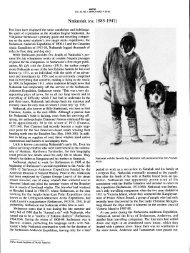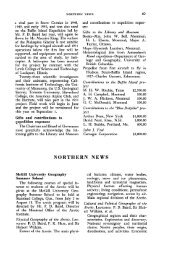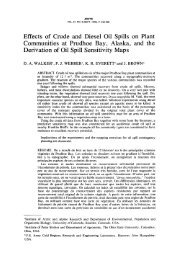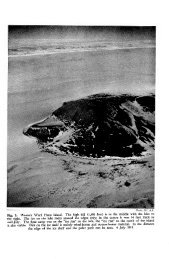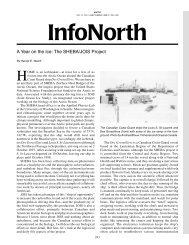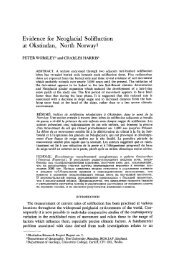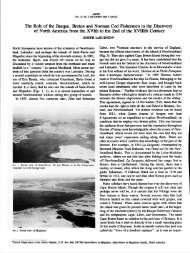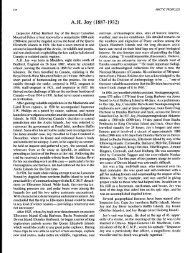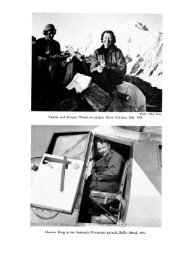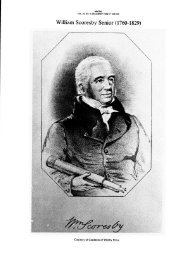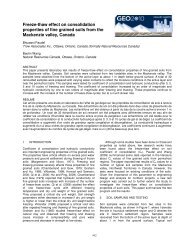Noteworthy Vascular Plants Collected in Southwestern Banks Island ...
Noteworthy Vascular Plants Collected in Southwestern Banks Island ...
Noteworthy Vascular Plants Collected in Southwestern Banks Island ...
Create successful ePaper yourself
Turn your PDF publications into a flip-book with our unique Google optimized e-Paper software.
F<strong>in</strong>ancial Support for Arctic<br />
The National Research Council of Canada<br />
authorized <strong>in</strong> March 1974 a publication grant<br />
<strong>in</strong> support of Arctic of which this note is an<br />
acknowledgement and a token of apprecia-<br />
tion.<br />
<strong>Noteworthy</strong> <strong>Vascular</strong> <strong>Plants</strong><br />
<strong>Collected</strong> <strong>in</strong> <strong>Southwestern</strong><br />
<strong>Banks</strong> <strong>Island</strong>, N.W.T.<br />
Dur<strong>in</strong>g the summers of 1968 and 1969,<br />
while conduct<strong>in</strong>g a geobotanical survey <strong>in</strong><br />
southwestern <strong>Banks</strong> <strong>Island</strong> (see Fig. l), the<br />
author made an extensive collection of plants.<br />
This paper comprises a list of vascular plants<br />
new to the Canadian Arctic Archipelago or to<br />
<strong>Banks</strong> <strong>Island</strong>, as well as comments on some<br />
rare species.<br />
The field studies were made possible by<br />
the National Research Council of Canada<br />
(1968) and by the Geological Survey of Canada<br />
(1969). The Polar Cont<strong>in</strong>ental Shelf<br />
Project supplied logistic support dur<strong>in</strong>g both<br />
summers.<br />
Specimens have been deposited <strong>in</strong> the<br />
Phanerogamic Herbarium of the Canada<br />
Department of Agriculture, Ottawa.<br />
Thanks are hereby extended to Drs. W. J.<br />
Cody, J. G. Fyles, A. E. Porsild and E. F.<br />
Roots (all from Ottawa) for their k<strong>in</strong>d<br />
assistance.<br />
Achillea nigrescens (E. Mey.) Rydb.<br />
Found <strong>in</strong> the Masik River valley: <strong>in</strong> s<strong>in</strong>gle<br />
localities on the delta, <strong>in</strong>land commonly up<br />
to 600 ft. on south-fac<strong>in</strong>g slopes, but rarely<br />
as high as 300 ft. on north-fac<strong>in</strong>g ones; absent<br />
<strong>in</strong> the <strong>in</strong>nermost parts of the valley. Several<br />
depauperate specimens found on alluvium <strong>in</strong><br />
the middle reaches of the Kellett River valley.<br />
Its ma<strong>in</strong> habitats are well-exposed and<br />
moderately-elevated slopes where it grows on<br />
gravelly, muddy, peaty and weathered rock<br />
substrates. Previously reported from the<br />
middle part of the Masik River valleyl.<br />
Arctophila fulva (Tr<strong>in</strong>.) Anders.<br />
Common over the whole area <strong>in</strong> ponds,<br />
usually with Hippuris vulgaris, Eriophorum<br />
sp. and mosses Calliergun trifarium and<br />
Scorpidium scorpioides. Previously reported<br />
only from the northeastern corner of <strong>Banks</strong><br />
<strong>Island</strong>z.<br />
FIG. 1. Distribution of some plant species <strong>in</strong> southwestern <strong>Banks</strong> <strong>Island</strong>, N.W.T.
SHORT PAPERS AND NOTES 147<br />
Arenaria sajanensis Willd.<br />
Common up to 1,000 ft. <strong>in</strong> mounta<strong>in</strong>s ad-<br />
jacent to the south of the Masik River valley<br />
where it forms abundant cushions on stony<br />
beds <strong>in</strong> the upper reaches of streams. Rare<br />
at lower elevations on alluvium. From <strong>Banks</strong><br />
<strong>Island</strong> previously recorded only as a rare plant<br />
from two coastal localities (Sachs Harbour<br />
and Cape Lembton) by Porsildj. A montane<br />
element <strong>in</strong> the <strong>Banks</strong> <strong>Island</strong> flora.<br />
Artemisia borealis Pall.<br />
Common on sunny, dry and elevated<br />
slopes, on coastal cliffs and on alluvium.<br />
Found up to 600 ft. <strong>in</strong> the Masik River<br />
valley. New to <strong>Banks</strong> <strong>Island</strong>.<br />
A. hyperborea Rydb.<br />
Common over the entire area. Coastal<br />
specimens are short or even stunted. Found<br />
among open vegetation, on stony and dry<br />
soils. Previously reported from the Masik<br />
River valleyl.<br />
A. tilesii Ledeb.<br />
Common <strong>in</strong> the Sachs River valley and<br />
the Masik River valley, elsewhere rare.<br />
Luxuriant specimens grow on drier places <strong>in</strong><br />
valley bottoms <strong>in</strong> sheltered depressions on<br />
lower slopes, on marg<strong>in</strong>s of Salix alaxensis<br />
stands, and near houses <strong>in</strong> Sachs Harbour<br />
village. Only depauperate specimens are<br />
present on open and w<strong>in</strong>dswept places. Found<br />
at altitudes up to 800 ft. On the northern<br />
roll<strong>in</strong>g parts of the area it is rare. <strong>Banks</strong> <strong>Island</strong><br />
specimens, except those from Sachs Harbour<br />
village, are much shorter than those from the<br />
subarctic (e.g., vic<strong>in</strong>ity of Inuvik). Previously<br />
reported from the north coast of the island2<br />
and from the middle reaches of the Masik<br />
River valleyl.<br />
Aster pygmaeus L<strong>in</strong>dl.<br />
One flower<strong>in</strong>g specimen (3 <strong>in</strong>. tall) found<br />
on alluvium <strong>in</strong> the middle of Kellett River,<br />
and several specimens <strong>in</strong> the delta of Masik<br />
River and on adjacent gravelly alluvial ter-<br />
races (see Fig. 1). These are northernmost<br />
locations of A. pygmaeus (see Porsild2).<br />
Carex urs<strong>in</strong>a Dew.<br />
Found on sandy and muddy shores between<br />
Lennie River and Sachs Harbour. Most<br />
abundant on Cape Kellett (see Kuc4) and at<br />
southern Blue Fox Po<strong>in</strong>t. Hitherto not re-<br />
ported from the west coast of <strong>Banks</strong> <strong>Island</strong>.<br />
Crepis nana Richards.<br />
Found on top of the mora<strong>in</strong>ic hill between<br />
the mouths of Masik and Atitok Rivers (see<br />
Fig. l), numerous luxuriant specimens be<strong>in</strong>g<br />
located near nests of Snowy Owl. New to<br />
<strong>Banks</strong> <strong>Island</strong>.<br />
Descuro<strong>in</strong>ia sophioides (Fisch.) 0. E. Schultz<br />
Common and abundant <strong>in</strong> Sachs Harbour<br />
village <strong>in</strong> anthropogenic habitats: mostly old<br />
refuse heaps or places laid bare by man, e.g.,<br />
along roads and cliffs, and <strong>in</strong> the Masik River<br />
valley at several localities associated with<br />
former Eskimo camps and bare, eroded river<br />
banks (depauperate forms) (see Fig. 1).<br />
Hitherto known at one locality on <strong>Banks</strong><br />
<strong>Island</strong> (see Porsildz).<br />
Dryas chamissonis Juz.<br />
Found at Swan Lake on bare soil, <strong>in</strong> dry<br />
parts of moss-bogs and <strong>in</strong> sheltered places<br />
(see Fig. 1). Specimens are sterile. This species<br />
is neglected by botanists, although it is<br />
morphologically quite readily recognized by<br />
its flat, non-sh<strong>in</strong>y and coarsely crenulated<br />
leaves etc. (see Porsilds). Young, immature<br />
leaves are very similar to D. <strong>in</strong>tegrifolia. Det.<br />
A. E. Porsild.<br />
Halimolobus mollis (Hook.) Roll<strong>in</strong>s<br />
Found <strong>in</strong> refuse heaps <strong>in</strong> Sachs Harbour<br />
village and <strong>in</strong> the Masik River valley <strong>in</strong> areas<br />
of former Eskimo camps. Specimens were<br />
seen only <strong>in</strong> habitats disturbed by man.<br />
Previously reported from the middle reaches<br />
of the Masik River valleyl.<br />
Melandrium ostenfeldii Porsild<br />
Most commonly found on slopes with<br />
southern exposures <strong>in</strong> the Masik River valley.<br />
Rare <strong>in</strong> other parts of the area studied: <strong>in</strong> the<br />
middle of Kellett River valley, on slopes<br />
above Sachs Harbour village and at Sand<br />
Hills. These are the northernmost known<br />
locations of the species1.2.<br />
Melandrium triflorum (R. Br.) J. Vahl<br />
Found at Sachs Harbour village on coastal<br />
cliffs. High Arctic specimens (e.g. from<br />
Eureka or Mould Bay) are taller and better<br />
developed <strong>in</strong> all respects than those from<br />
Sachs Harbour, which have dist<strong>in</strong>ctly smaller<br />
leaves and flowers and th<strong>in</strong>ner stems. New<br />
for the southern part of <strong>Banks</strong> <strong>Island</strong>, which<br />
is one of its southernmost locations (see<br />
Porsildz).<br />
Parnassia kotzebuei Cham. & Schlecht.<br />
Found on alluvium <strong>in</strong> the Masik River<br />
area from the coast to the upper reaches of<br />
valleys, but most common <strong>in</strong> the middle part<br />
of the ma<strong>in</strong> valley; between stones <strong>in</strong> dry<br />
stream beds, on sandy, muddy, and gravel
148 SHORT PAPERS AND NOTES<br />
alluvial and deltaic deposits; rare among wet<br />
tundras <strong>in</strong> places with runn<strong>in</strong>g water and on<br />
moist eroded ground; s<strong>in</strong>gle specimens on<br />
alluvium <strong>in</strong> the middle part of Kellett River<br />
and on bogs of the Sachs River valley. <strong>Banks</strong><br />
<strong>Island</strong> is the northernmost part of the range<br />
of P. kotzebueilJv6.<br />
Phlox richardsonii Hook.<br />
Common, but conf<strong>in</strong>ed to coastal cliffs and<br />
alluvium (see Fig. 1). Grows on loose sand<br />
and gravel. The best developed and largest<br />
cushions occur on slopes fac<strong>in</strong>g the sea and<br />
around houses <strong>in</strong> Sachs Harbour. Inland it<br />
was observed only on the northern slopes of<br />
the lower part of Kellett River, where it grows<br />
<strong>in</strong> small tufts or <strong>in</strong> s<strong>in</strong>gle specimens.<br />
Plantago septata Morris<br />
Found at many localities at the mouth of<br />
Lennie River, along Kellett River and Sachs<br />
River, on coastal hills around Thesiger Bay,<br />
<strong>in</strong> abundance at Sachs Harbour village, and<br />
on sunny slopes up to 600 ft. <strong>in</strong> the Masik<br />
Valley. It grows on dry, stony and loose<br />
substrates. These are the northernmost known<br />
locations of this plant (see Mason et dl,<br />
Porsildz).<br />
Pleuropogon sab<strong>in</strong>ei R. Br.<br />
Very rare plant, found <strong>in</strong> several tundra<br />
ponds between Sachs Harbour Meteorological<br />
Station and Kellett River, and <strong>in</strong> the small<br />
pool <strong>in</strong> Sachs Harbour village. These are the<br />
southwesternmost locations of the species.<br />
Potentilla nivea L.-s. s.<br />
Found <strong>in</strong> the Sachs Harbour area (especial-<br />
ly frequently <strong>in</strong> anthropogenic habitats <strong>in</strong><br />
Sachs Harbour village) among drier parts of<br />
tundra, on loose m<strong>in</strong>eral soils of southern<br />
exposures. This is the only known location of<br />
the species on the island.<br />
Pulsatilla ludoviciana (Nutt.) Heller<br />
Rare <strong>in</strong> low and middle elevated, southern<br />
and dry exposures <strong>in</strong> the Masik River valley<br />
(see also Mason et dl), but very rare on<br />
north-fac<strong>in</strong>g exposures. Seen also <strong>in</strong> the<br />
vic<strong>in</strong>ity of Sachs Harbour village.<br />
Pyrola secunda var. obtusata Turcz.<br />
Found between Carpenter Lake and Sachs<br />
River (see Fig. 1) among Dryas <strong>in</strong>tegrifolia<br />
and mosses, on tops of moss hummocks with<br />
humic soil. Specimens are sterile and very<br />
small, and their stems are th<strong>in</strong> and have few<br />
leaves. This is the northernmost reported<br />
location of this plant <strong>in</strong> the Arctic.<br />
Rumex arcticus Trautv.<br />
Luxuriant specimens found on anthropogenic<br />
habitats <strong>in</strong> Sachs Harbour village are<br />
up to 3 ft. tall, with large, wide leaves, thick<br />
stems and <strong>in</strong>florescences abundantly flowered.<br />
S<strong>in</strong>gle smaller plants occur on coastal cliffs<br />
and on beaches around Thesiger Bay. Specimens<br />
from more <strong>in</strong>land localities are dist<strong>in</strong>ctly<br />
depauperate (low, with narrow, short<br />
leaves, th<strong>in</strong> stems and few flowered <strong>in</strong>tlorescences).<br />
Fig. 1 <strong>in</strong>dicates the locations. Coastal<br />
plants usually grow on loose soils and <strong>in</strong> wellexposed<br />
places, whereas <strong>in</strong>land specimens are<br />
found on gravel, muddy or sandy flats and<br />
stony, barren substrates. It is new to the Canadian<br />
Arctic Archipelago.<br />
Salix alaxensis (Anderss.) Cov.<br />
S. alaxensis has been more carefully studied<br />
than other plants because of its <strong>in</strong>terest<strong>in</strong>g<br />
ecology, its peat-form<strong>in</strong>g properties and its<br />
occurrence <strong>in</strong> <strong>in</strong>terglacial and postglacial<br />
deposits7~sJ) that have great significance <strong>in</strong><br />
trac<strong>in</strong>g the development of the flora on <strong>Banks</strong><br />
<strong>Island</strong>.<br />
Generally, this is a common species <strong>in</strong> the<br />
<strong>in</strong>terior of the island, but it is absent, or very<br />
rare, on the coast. Large clumps of S.<br />
alaxensis were observed many times from the<br />
air <strong>in</strong> swampy areas <strong>in</strong> the upper parts of<br />
Barnard River and Big River. Its distribution<br />
over the area studied is shown <strong>in</strong> Fig. 1. It is<br />
possible to dist<strong>in</strong>guish three zones of occurrence:<br />
1 - <strong>in</strong>dividual localities near the coast;<br />
2 - groups of localities associated with areas<br />
of old peat deposits, sheltered valleys and<br />
larger alluvial patches; and 3 - large patches<br />
cover<strong>in</strong>g the lowest <strong>in</strong>land slopes, old alluvium<br />
and <strong>in</strong> swamps. The altitud<strong>in</strong>al range<br />
of S. alaxensis is also very <strong>in</strong>terest<strong>in</strong>g. It is<br />
absent, or very rarely found, on level terra<strong>in</strong><br />
of elevation up to 50 ft. In the ma<strong>in</strong> it is<br />
found only <strong>in</strong> level areas away from the<br />
coast, and farther <strong>in</strong>land on slopes of elevation<br />
50-300 ft. It does not grow <strong>in</strong> summit<br />
areas but loose small clumps of it are to be<br />
seen at heights of up to 500 ft.<br />
In the past this plant was more widely<br />
distributed than at present, as is shown by<br />
twig and moss deposits conta<strong>in</strong><strong>in</strong>g its rema<strong>in</strong>s<br />
(often as subdom<strong>in</strong>at<strong>in</strong>g components) and<br />
associated with Sphagnum7.10 of <strong>in</strong>terglacial<br />
age (older than 43,000 radiocarbon years,<br />
GSC-1293) <strong>in</strong> the coastal cliff at Worth Po<strong>in</strong>t.<br />
Betula sp. lower <strong>in</strong> the same section is<br />
>54,000 years old (GSC-1236). Its branches<br />
are also common but are not associated with<br />
Sphagnum peat <strong>in</strong> postglacial strata (younger<br />
than 9730 2 150 years, GSC-1525) exposed<br />
<strong>in</strong> the coastal cliff between Middle Lake and
SHORT PAPERS AND NOTES 149<br />
Sand Hills and on alluvium <strong>in</strong> the lower part<br />
of the Masik River Valley7,g.<br />
Edaphic and climatic requirements of S.<br />
alaxensis on <strong>Banks</strong> <strong>Island</strong> can be described<br />
as follows. Well developed specimens and<br />
their stands occur on moist humic soils, on<br />
muddy and gravelly alluvium and on screes.<br />
Specimens are dist<strong>in</strong>ctly better developed <strong>in</strong><br />
sheltered and deep depressions with thick<br />
snow cover <strong>in</strong> w<strong>in</strong>ter (Fig. 2). Luxuriant<br />
forms (Fig. 3) appear around larger bodies<br />
of water with shallow shores, along slowly<br />
runn<strong>in</strong>g streams on old alluvial terraces and<br />
on well watered screes adjacent to valley<br />
bottoms. The most depauperate forms occur<br />
<strong>in</strong> frost cracks both near the sea and at<br />
highest elevations. The habitats of S. alaxensis<br />
<strong>in</strong> areas south of <strong>Banks</strong> <strong>Island</strong> are dist<strong>in</strong>ctly<br />
different. Observations were made near Tuk-<br />
toyaktuk and Inuvik and <strong>in</strong> many places be-<br />
tween Great Bear Lake and the Mackenzie<br />
FIG. 2. Salis alaxensis<br />
community <strong>in</strong> the middle<br />
part of the Masik River<br />
valley.<br />
FIG. 3. Luxuriant<br />
specimen of Salix<br />
alaxensis (Anderss.) cov.<br />
Mounta<strong>in</strong>s, mostly <strong>in</strong> the Norman Wells area.<br />
In the vic<strong>in</strong>ity of Tuktoyaktuk S. alaxensis<br />
is not dom<strong>in</strong>ant <strong>in</strong> the shrubby tundra, but<br />
is often subdom<strong>in</strong>ant <strong>in</strong> the dense shrubby<br />
growth composed of Betula glandulosa and<br />
Alnus crispa. In such habitats specimens of<br />
S. alaxensis are quite similar to the luxuriant<br />
forms on <strong>Banks</strong> <strong>Island</strong>.<br />
Around Inuvik the plant occupies two<br />
ma<strong>in</strong> habitats. (1) It grows on fluvial mud flats<br />
and forms pure stands up to 18 ft. high, with<br />
the ground layer ma<strong>in</strong>ly composed of Equi-<br />
setum arvense; plants are tail and thick<br />
(ma<strong>in</strong> branches reach 2 <strong>in</strong>. <strong>in</strong> diameter), with<br />
long annual lengths of term<strong>in</strong>al twigs that are<br />
entirely different from those on <strong>Banks</strong> <strong>Island</strong><br />
and at Tuktoyaktuk. (2) In bogs it grows <strong>in</strong><br />
groups together with some associates which<br />
do not occur <strong>in</strong> the Canadian Arctic<br />
Archipelago.<br />
In the Norman Wells area, which is close
150 SHORT PAPERS AND NOTES<br />
to the southern border of the species, the<br />
plant is a component of the dense, Sdix-<br />
Betula-Populus growth occurr<strong>in</strong>g along<br />
streams, <strong>in</strong> ditches and around bogs. Specimens<br />
are tall, though th<strong>in</strong>, densely branched,<br />
and usually grow<strong>in</strong>g <strong>in</strong> groups (see Codyll).<br />
Extreme life forms have specimens <strong>in</strong> the<br />
lower alp<strong>in</strong>e belt of the Mackenzie Mounta<strong>in</strong>s<br />
where they grow on dry rocky soils, often <strong>in</strong><br />
w<strong>in</strong>dy places, but rarely among deeper bogs<br />
and denser plant communities <strong>Plants</strong> are<br />
short with dense, thick, strongly-twisted stems<br />
dist<strong>in</strong>ctly damaged by w<strong>in</strong>d <strong>in</strong> upper parts.<br />
S. alaxensis is a subarctic species common<br />
Salix richardsonii Hook.<br />
Common <strong>in</strong> the Masik River valley, es-<br />
pecially on older alluvium ascend<strong>in</strong>g to 500<br />
ft. In the Sachs River valley also frequent on<br />
alluvium and <strong>in</strong> moss-bogs. Several small<br />
clumps were found on alluvium of the middle<br />
of Kellett River (cf. Mason et ~1.1).<br />
Stellaria edwardsii R. Br.<br />
<strong>Collected</strong> only twice: (1) on swamps be-<br />
tween lakes near the middle of Sachs River<br />
and (2) <strong>in</strong> depressions <strong>in</strong> wet tundra near<br />
Thesiger Bay -though commonly observed<br />
<strong>in</strong> many other places. New to <strong>Banks</strong> <strong>Island</strong>.<br />
Det. A. E. Porsild.<br />
Marian Kuc<br />
Terra<strong>in</strong> Sciences Division<br />
Geological Survey of Canada<br />
Ottawa KIA OE8, Canada<br />
REFERENCES<br />
'Mason, W. R. M., G. E. Shewell and W. J.<br />
Cody. 1972. A plant collection from the<br />
southern <strong>in</strong>terior of <strong>Banks</strong> <strong>Island</strong>, N.W.T.<br />
Canadian Field-Naturalist, 86(4): 363-67.<br />
ZPorsild, A. E. 1964. Illustrated flora of the<br />
Canadian Arctic Archipelago. Canada,<br />
National Museum, Bullet<strong>in</strong> 146 (2nd ed.).<br />
3- . 1955. The vascular plants of<br />
the western Canadian Arctic Archipelago.<br />
Canada, National Museum, Bullet<strong>in</strong> 135.<br />
~Kuc, M. Vegetation map of Cape Kellett,<br />
southwestern <strong>Banks</strong> <strong>Island</strong>, N.W.T. (man-<br />
uscript).<br />
bPorsild, A. E. 1947. The genus Dryas <strong>in</strong><br />
North America. Canadian Field-Naturalist,<br />
61(6): 175-92.<br />
BHultbn, E. 1968. Flora of Alaska and Neighbour<strong>in</strong>g<br />
Territofiies. Stanford, Calif .: Stanford<br />
University Press. 1008 pp.<br />
~Kuc, M. 1970. Peat deposits and fossil<br />
<strong>in</strong> the west and rare towards the east, but mosses <strong>in</strong> the Arctic. Canada, Geological<br />
reach<strong>in</strong>g Hudson Bay. To the south it is Survey, Paper 70-1, part A: 161-62.<br />
alp<strong>in</strong>e. Differences <strong>in</strong> the behaviour of the<br />
8- . 1970. <strong>Vascular</strong> plants from some<br />
plant <strong>in</strong> the above areas (<strong>Banks</strong> <strong>Island</strong>, Tuktoyaktuk,<br />
Inuvik, Norman Wells and the localities <strong>in</strong> the western and northern parts<br />
Mackenzie Mounta<strong>in</strong>s) show that this narrow<br />
of the Canadian Arctic Archipelago. Canarang<strong>in</strong>g<br />
species can adapt itself to vary<strong>in</strong>g<br />
dian Journal of Botany, 48: 1931-38.<br />
environments and climates.<br />
9- . 1973. Additions to the arctic<br />
S. alaxensis on <strong>Banks</strong> <strong>Island</strong> is one of the moss flora, VI: moss flora of Masik River<br />
ma<strong>in</strong> components of twig and mossy peat, <strong>in</strong> valley (<strong>Banks</strong> <strong>Island</strong>) and its relationship<br />
which it is represented mostly by thick with plant formations and postglacial hisbranches<br />
and nearly entire root systems. tory. Revue bryologique et lichenologique,<br />
Stems, <strong>in</strong> addition to their thickness and the 39(2): 253-64.<br />
characteristic type of branch<strong>in</strong>g, have dist<strong>in</strong>ct loCraig, B. G. and J. G. Fyles. 1960. Pleisstriation<br />
and nodes on the surface of the tocene geology of Arctic Canada. Canada,<br />
wood.<br />
Geological Survey, Paper 60-10.<br />
11Cody, W. J. 1960. <strong>Plants</strong> of the vic<strong>in</strong>ity of<br />
Norman Wells, District of Mackenzie,<br />
N.W.T. Canadian Field-Naturalist, 74(2):<br />
71-100.<br />
Three-rooted Mandibular<br />
First Permanent Molars <strong>in</strong><br />
Greenland Eskimo Skulls<br />
The first permanent mandibular molar nor-<br />
mally has two roots; however, <strong>in</strong> a number<br />
of <strong>in</strong>dividuals a third root develops. This<br />
anomaly with three roots (3RM1) occurs <strong>in</strong><br />
between 0.9%1 and 3.4%2 of Caucasians.<br />
The anomaly is unknown <strong>in</strong> the Negro, but<br />
<strong>in</strong> Mongoloid races is of such a high<br />
prevalence as to be termed a racial charac-<br />
teristic. In Eskimos and Aleuts the percentage<br />
of <strong>in</strong>dividuals show<strong>in</strong>g the anomaly has been<br />
variously reported as between 43.7%3 and<br />
12.5%4. The wide variation <strong>in</strong> reports based<br />
on studies of arctic peoples leads to the sus-<br />
picion that the prevalence of 3RM1 may vary<br />
accord<strong>in</strong>g to the different sub-groups of<br />
Eskimos <strong>in</strong> different geographic areas of the<br />
Arctic.



